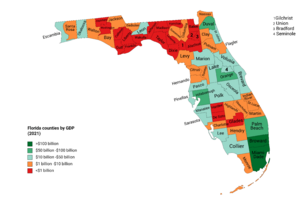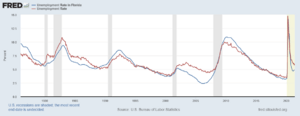Economy of Florida facts for kids
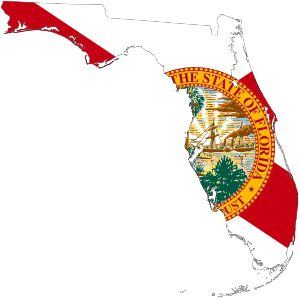 |
|
| Statistics | |
|---|---|
| GDP | $1.6 trillion (2024) |
|
GDP per capita
|
$72,861 (2024) |
| Unemployment | 2.7% (Aug. 2022) |
The economy of Florida is one of the biggest in the United States. It's the fourth-largest economy among all U.S. states. In 2024, Florida's economy made about $1.6 trillion worth of goods and services.
If Florida were its own country, its economy would be the 15th largest in the world! That's bigger than Spain and just a bit smaller than South Korea. Many things help Florida's economy grow. These include farming, tourism, building new things, banking, science, healthcare, space travel, and defense.
Contents
Florida's Big Economy
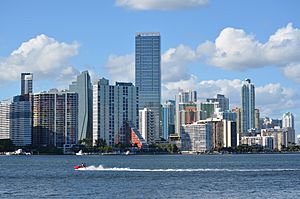
Florida's economy is one of the strongest in the U.S. In 2024, the total value of goods and services produced in Florida was about $1.6 trillion. This makes it the fourth-largest economy in the country. Florida creates about 5.82% of the total money made in the entire United States.
If Florida were a country, its economy would be larger than 15 other countries. It would be bigger than Spain and almost as big as South Korea. The state's economy gets a boost from many areas. These include farming, tourism, factories, construction, international banking, and medical research. Space travel and defense also play a big part.
The top five job areas in Florida are:
- Trade, transportation, and utilities (like shipping and stores)
- Government jobs
- Professional and business services (like lawyers and consultants)
- Education and health services (schools and hospitals)
- Leisure and hospitality (hotels and restaurants)
Florida also exports many goods to other countries. In 2017, it was the eighth-largest exporter of goods in the U.S. Its main export partners are Brazil, Canada, Mexico, Germany, and Colombia. Florida also imports many goods. In 2017, it was the tenth-largest importer in the U.S. Its main import partners are China, Mexico, Canada, Germany, and France.
The Miami Metropolitan Area has the largest economy within Florida. In 2017, it produced $344.9 billion. This is more than double the next biggest area, the Tampa Bay Area, which made $145.3 billion. Most of Florida's economy comes from its big cities and surrounding areas.
In 2017, the average income per person in Florida was $39,842. This ranked 40th in the nation. Income can be very different depending on where you live and what job you have. Some parts of North Florida and the Florida Panhandle have lower incomes. However, many cities along the coast have some of the wealthiest people in the U.S.
In 2018, Florida had over 427,824 millionaires. This was the fourth-highest number in the country. The state's budget for 2018–19 was $88.7 billion. In 2011, Chief Executive Magazine called Florida the third "Best State for Business." In July 2022, Florida's unemployment rate dropped to a very low 2.7%. This means many people have jobs.
Money and Jobs
In 2017, the average personal income in Florida was $47,684. This placed Florida 26th in the nation. In September 2018, the unemployment rate was 3.5%. This was one of the lowest rates in the U.S. Florida is also one of seven states that does not have a personal income tax. This means people don't pay a state tax on their earnings.
In 2017, the total personal income for everyone in Florida was over $1 trillion. This was the 4th highest in the United States.
Florida has a state minimum wage that changes each year based on inflation. As of September 2021, the minimum wage was $6.98 per hour for jobs where you get tips. For jobs where you don't get tips, it was $10.00 per hour. This was higher than the national minimum wage of $7.25. The wage will go up by $1 per hour each year until 2026. By then, the minimum wage for non-tipped jobs will be $15 per hour.
Key Industries
Farming
Florida is a top farming state. In 2019, it was ranked first in the U.S. for growing fresh bell peppers and tomatoes. It also led in grapefruit, oranges, sugarcane, and watermelons. Citrus fruits, especially oranges, are a very important part of Florida's farming economy. Meat is also a big export for Florida.
Strawberries
Strawberry is another important crop in Florida. Florida is second only to California in how many strawberries it grows each year. The Plant City area grows about three-quarters of America's winter strawberries. Strawberry growers in Florida ship their fruit from December to April. The Florida Strawberry Festival is held every March in Plant City.
Some popular types of strawberries grown here are 'Florida Radiance', 'Strawberry Festival', and 'Florida Beauty'.
Peaches
Peaches have been grown in Florida since the 1500s. Spanish settlers brought them. By the late 1700s, Florida was exporting peaches to other states. Peaches are becoming a more popular crop in Florida. This is partly because of a disease called citrus greening that affects orange trees.
Florida grows far fewer peaches than California, but it has an advantage. Its peach season starts earlier than any other state, from late March to early June.
Citrus
Citrus farming in Florida also started in the 1500s. But growing citrus on a large scale only began in the 1920s. In 2019, oranges made up 93% of Florida's citrus production. Grapefruit was 6%, and tangerines and tangelos were 1%. Most of the oranges grown in Florida (about 95%) are used to make orange juice. Orange juice is the official state beverage.
The top five counties for citrus production in 2019 were DeSoto, Polk, Highlands, Hendry, and Hardee. These counties together grew 71% of Florida's citrus. Florida also exports fresh citrus fruit. Japan receives most of the grapefruit exports. Canada gets most of Florida's orange and tangerine exports.
Other Crops
The biggest part of Florida's farming by sales is the $2.3 billion ornamental industry. This includes plants from nurseries, greenhouses, flowers, and sod (grass for lawns).
Other important crops include sugarcane, tomatoes, and celery. Florida is the largest producer of sweet corn and green beans in the U.S. The Everglades Agricultural Area is a big farming region. However, farming can affect the environment, especially by causing water pollution.
Florida also grows most of the saw palmetto berries in the country. These are used in some natural medicines.
Florida is number one in growing fresh tomatoes. They are harvested almost all year, from October to June.
Much of the okra in the U.S. is grown in Florida, especially around Dade. Okra is available for ten months of the year.
California and Florida grow most of the commercial Persimmons in the United States.
Fishing
In 2009, fishing was a $6 billion industry in Florida. It provided 60,000 jobs for both sports fishing and commercial fishing. In 2018, Florida's aquaculture (fish farming) businesses reported sales of $72 million.
Mass Media
Broadband Internet is available in Florida from both government groups and private companies.
Mining
Phosphate mining is Florida's third-largest industry. It is mostly found in the Bone Valley area. Florida produces about 75% of the phosphate needed by U.S. farmers. It also produces 25% of the world's supply. About 95% of phosphate is used for farming, mostly for fertilizer.
Biotech
After Hurricane Andrew in 1992, Florida started investing in new types of businesses. The state wanted to make its economy stronger, so it wouldn't rely only on tourism. One of these new areas was Medical/Bio-Sciences. In 2003, The Scripps Research Institute (TSRI) decided to open a big science center in Palm Beach County.
Real Estate
In the early 1900s, people started buying land in Florida. Businessmen like Henry Plant and Henry Flagler built railroads. This made it easier for people to move to Florida, attracted by the nice weather and job opportunities. Tourism grew a lot, which led to more building. This building boom sometimes took over farmland.
In 2009, Florida had many empty homes, about 300,000. This was after a period of a lot of building. In 2009, people in Florida spent about 49.1% of their income on housing costs. This was the third-highest percentage in the U.S.
By February 2010, sales of existing homes were up 21% from the year before. The average price for an existing house was $131,000.
Seaports and Boating

Florida has many important seaports. These ports handle large cargo ships, oil tankers, and cruise ships. Some major ports include Port Tampa Bay, Port Everglades (Fort Lauderdale), Port of Jacksonville, PortMiami, and Port Canaveral.
The world's top three busiest cruise ports are all in Florida! PortMiami is the busiest, followed by Port Canaveral and Port Everglades. Port Tampa Bay is the largest port in Florida by the amount of goods it handles. As of 2013, it was the 16th busiest port in the U.S. for domestic trade. It helps create over $15.1 billion for the economy and supports more than 80,000 jobs.
Florida is also the top state for selling powerboats. In 2013, boat sales reached $1.96 billion.
Tourism
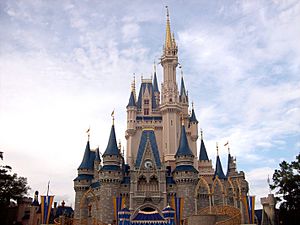
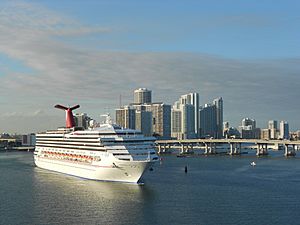
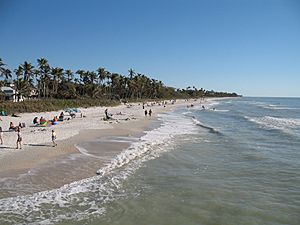
If you can't find something to do in Florida, you're just boring ...
—Guy Fieri, celebrity chef, 2017
Tourism is one of the biggest parts of Florida's economy. In 2016, almost 1.4 million people worked in the tourism industry. This was a record for the state.
In 2015, Florida welcomed over 100 million visitors for the first time ever. The state has set new tourism records for eight years in a row. In 2018, a record 126.1 million visitors came to Florida.
Many beach towns are popular places for tourists, especially during winter and spring break. In 2000, 23 million tourists visited Florida beaches and spent $22 billion.
Recent data shows that 30.9 million visitors came to Florida from October to December 2021. This was a big increase from 2020 and even more than before the pandemic.
Amusement parks, especially around Greater Orlando, bring in many tourists. The Walt Disney World Resort is the most visited vacation spot in the world. It has over 58 million visitors each year. It includes four theme parks, many hotels, water parks, and golf courses. Other big theme parks in the area are Universal Orlando Resort, SeaWorld Orlando, and Busch Gardens Tampa.
Florida's many state parks and protected natural areas also attract a lot of visitors. In 2013, 25.2 million people visited Florida State Parks.
Tourists also come to Florida to watch rocket launches in person. The Kennedy Space Center Visitor Complex had 1.7 million visitors in 2016.
See also
 In Spanish: Economía de Florida para niños
In Spanish: Economía de Florida para niños


